What is the Best GPU Server for AI and Machine Learning?
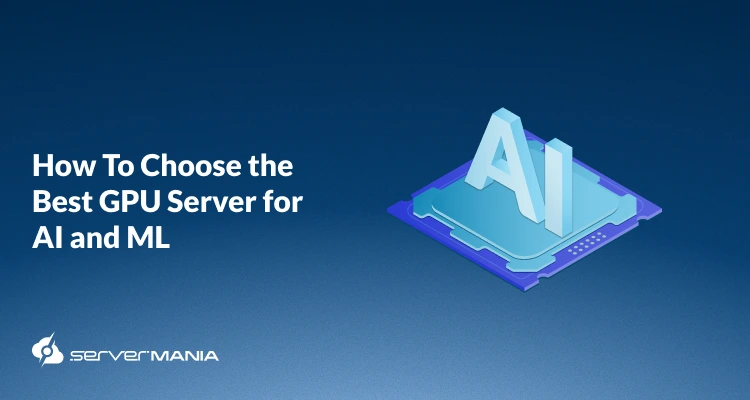
The rise of Artificial Intelligence (AI) and Machine Learning (ML) in 2025 is imminent, and many industries are undergoing a revolution from the ground up.
This “revolution” covers everything from automation, generative modeling, and almost every corner of computing, so adapting to these changes is as crucial for business as to individuals.
With over two decades of expertise, ServerMania stands out with robust GPU server hosting solutions, GPU dedicated servers, and GPU server clusters. We’ve helped numerous businesses set up, configure, and migrate their data over to one of our secure data centers, while focusing on growth and scalability.
So, in this article, we will explore GPU servers, narrowing down the prime options for AI and Machine Learning. Our aim is to equip you with comprehensive insights into the machine learning GPU market, facilitating informed decision-making regarding AI infrastructure.
What is a GPU Server?
A GPU server is a specialized variant designed to leverage the powerful processing capabilities of GPUs for parallel tasks.
In contrast to the traditional CPU servers designed for power processing or “linear processing”, GPU servers stand out in executing computations concurrently.
This is the unique ability of GPU servers that is making them the perfect solution for many of the latest demanding computational AI projects. Some of them include:
- Neural Network Training
- Scientific Simulations
- Deep Learning Frameworks
- Extensive Data Analysis
- Image Recognition
GPU Servers: Advantages and Disadvantages
When it comes to the GPU servers and their performance, specifically dedicated to ML and AI tasks, there are a lot of advantages, as well as disadvantages that we shouldn’t overlook. While GPU servers can process large volumes of data in parallel, in 2025, they are still far from perfect.
Here is a quick breakdown of their standout pros and cons:
| Advantages: | Disadvantages: |
| High-Performance: GPU servers are excellent in handling tensor operations, which translates into shorter ML training times. | Cost: GPU servers have a higher upfront cost, especially the initial investment. |
| Low Power Draw: GPU servers are much more power-efficient when it comes to performance–per-watt, compared to CPUs. | Cooling: GPUs generate more heat and require stronger and more expensive cooling solutions. |
| High Scalability: GPU servers can scale easily and meet the needs of growing businesses. | Availability: The high demand often brings supply challenges and delayed deployments. |
| High Bandwidth: GPU servers feature far greater memory bandwidth and enhanced handling for memory-intensive workloads. | Complexity: GPU servers are significantly complex and require knowledge, typically leading to a higher cost. |
| High Compatibility GPU servers integrate easily with community platforms such as PyTorch and TensorFlow. | Necessity GPU servers may not always be needed, especially for simpler applications and workloads. |
See Also: GPU Temperature Range
Factors to Evaluate When Selecting a GPU Server
There are a few important factors you need to consider when choosing and oi your GPU server, which will play a vital role in your business’s future:
- GPU Model: The graphics processor is at the heart of your server, so you should check the latest models, such as NVIDIA L4 24GB Tensor Core, AMD MI300X, Intel Gaudi3, and NVIDIA H200.
- CPU and RAM: Even though the central processor (CPU) is managing the demanding applications, a good amount of RAM is critical to feed the CPU’s demands.
- Storage: When it comes to storage, the quick communication between the storage, RAM, and CPU is mandatory, so a high-speed Solid State Drive (SSD) is important.
- Software Compatibility: You need to carefully consider the operating system and its compatibility with the key AI libraries like PyTorch, TensorFlow, and CUDA.
- Upgradability: Businesses’ scale and requirements grow fast, so your server must be able to accommodate more GPU upgrades when needed, as needed.
See Also: AMD vs. NVIDIA GPU | Complete Comparison
Why are GPUs Better than CPUs for Machine Learning?
In machine learning, even a basic GPU outperforms a CPU due to its architecture. GPUs are faster than CPUs for deep neural networks because they excel at parallel computing, allowing them to perform multiple tasks simultaneously. In contrast, CPUs are designed for executing those sequential tasks.
GPUs are particularly well-suited for artificial intelligence and deep learning frameworks, enabling the efficient training of deep neural networks for AI model tasks and DL training like image recognition, natural language processing, and generative modeling.
The architecture of GPUs includes many specialized cores that are capable of processing large datasets and delivering substantial performance improvements. Unlike CPUs, which allocate more transistors to caching and system memory flow control, GPUs focus more on arithmetic logic.
DL training GPUs offer high-performance computing power on a single chip and are compatible with modern machine-learning frameworks such as TensorFlow and PyTorch.
So, by integrating multiple GPUs (double width) into a single server equipped with a high-performance processor such as AMD EPYC or Intel Xeon Scalable, along with sufficient system memory, even the most demanding artificial intelligence tasks, processes, and loads can be executed quickly and reliably.
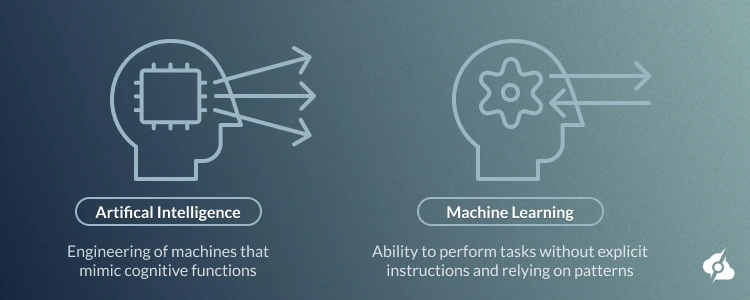
The Best GPUs for Machine Learning in 2025
Choosing the ideal GPU for complex machine learning models involves careful consideration and evaluation to ensure optimal performance. It requires assessing various factors such as the GPU’s capacity to handle deep learning algorithms, efficient utilization in deep neural networks, and the ability to execute complex computations effectively.
Therefore, in the following discussion, we highlight several GPU models and GPU configuration options to compare them, aiming to determine which GPU best aligns with the demands of machine learning.
NVIDIA L4 24GB Tensor Core
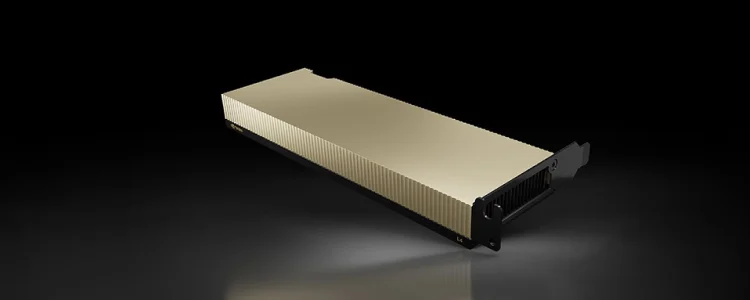
L4 is one of the most versatile NVIDIA GPUs on the market, a new generation card built for machine learning and AI workloads with impressive media acceleration.
Contrasting the massive data-center GPUs aimed solely at large-scale training, the L4 delivers a balance: strong throughput in real-world ML tasks while keeping energy consumption and thermal requirements manageable.
| NVIDIA L4 Specifications: | |
| FP 32 | 30.3 teraFLOPs |
| TF32 Tensor Core | 60 teraFLOPs |
| FP16 Tensor Core | 121 teraFLOPs |
| BFLOAT16 Tensor Core | 121 teraFLOPs |
| FP8 Tensor Core | 242.5 teraFLOPs |
| INT8 Tensor Core | 242.5 TOPs |
| GPU Memory | 24GB GDDR6 |
| GPU Memory Bandwidth | 300GB/s |
| Max Thermal Design Power (TDP) | 72W |
Benchmark Data for NVIDIA L4
The table below highlights the NVIDIA L4’s overall ML capabilities, showing strong performance in low-precision compute tasks like FP8/INT8 and FP16/BF16.
Let’s next take a look at some real-world ML tasks, illustrating how many samples per second the GPU can process and the latency for common workloads such as image classification, object detection, speech recognition, and medical imaging.
| Task (MLPerf v4.0) | Throughput | Latency |
| ResNet-50 (Image Classification) | ~12,097 samples/s | ~0.34 ms |
| RetinaNet (Object Detection) | ~220.5 samples/s | ~4.90 ms |
| RNN-T (Speech Recognition) | ~3,875.6 samples/s | ~19.34 ms |
| 3D-U-Net (Medical Imaging Segmentation) | ~41.5 samples/s | ~167 ms |
Sources: NVIDIA Blog, StorageReview.com, Dell Technologies Info Hub
AMD Instinct MI300X
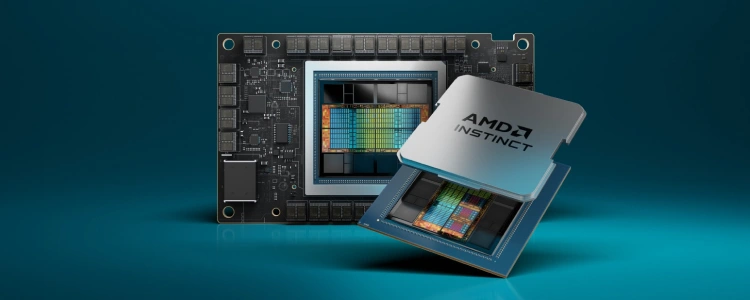
AMD MI300X is a high-end accelerator optimized for both large-scale inference and generative AI tasks such as image recognition. It offers large system memory, high bandwidth, and strong precision and flexibility for DL training and neural networks.
Its specs and ML benchmark submissions indicate it’s now among the top contenders for deploying big models without needing massive multi-GPU splitting.
Benchmark Data for AMD MI300X
Inference on MLPerf workloads, focusing on LLaMA2-70B (large language model). The MI300X stands out because a single GPU (192 GB HBM3) can host the full model without any splitting, cutting latency, and improving efficiency.
- Peak compute: ~1,307 TFLOPs (FP16/BF16), ~2,614 TFLOPs (FP8/INT8)
- Memory bandwidth: ~5.3 TB/s.
- In single-GPU use, it delivers strong real-time throughput.
- In 8-GPU configurations, performance scales nearly linearly.
The statistics below show how the AMD MI300X performs on MLPerf inference tasks with the LLaMA2-70B model. It highlights both single– and multi–GPU setups, showing real-time and batch throughput along with efficiency, demonstrating that the MI300X can handle large models in memory and scale nearly linearly with multiple GPUs.
| MLPerf v4.1, Inference with LLaMA2-70B | ||
| Task: | Throughput: | Latency / Notes: |
| 1× MI300X – Server Mode | ~2,520 tokens/s | Real-time inference throughput for LLaMA2-70B. |
| 1× MI300X – Offline Mode | ~3,063 tokens/s | Batch throughput; full model in memory avoids cross-GPU overhead. |
| 8× MI300X – Server Mode | ~21,028 tokens/s | Scales nearly linearly vs single GPU. |
| 8× MI300X – Offline Mode | ~23,515 tokens/s | Comparable to NVIDIA H100 DGX in similar scenarios. |
Sources: AMD, EETimes, SemiAnalysis
NVIDIA H200

The H200 is one of the best NVIDIA GPUs, specifically for AI infrastructure and ML high-performance computing, known as HPC workloads.
Built on the Hopper™ architecture, it offers significant advancements over its predecessor, the H100, particularly in memory capacity and bandwidth.
| NVIDIA H200 Specifications: | |
| GPU Memory | 141 GB HBM3e |
| Memory Bandwidth | 4.8 TB/s |
| FP8 Tensor Core Performance | 3,958 TFLOPS |
| FP16 / BFLOAT16 Tensor Core | 1,979 TFLOPS |
| INT8 Tensor Core Performance | 3,958 TOPs |
| TF32 Tensor Core Performance | 989 TFLOPS |
| FP32 Tensor Core Performance | 67 TFLOPS |
| FP64 Tensor Core Performance | 67 TFLOPS |
| Max Thermal Design Power (TDP) | Up to 700W |
| Interconnect | NVLink: 900 GB/s, PCIe Gen5: 128 GB/s |
Benchmark Data for NVIDIA H200
The NVIDIA H200 demonstrates exceptional performance on the LLaMA2-70B model, a large language model (LLM), under both server and offline server configurations.
| MLPerf v4.1, Inference with LLaMA2-70B | |||
| Configuration: | Throughput (tokens/s): | Latency (ms): | Notes: |
| 1× H200 – Server Mode | ~2,520 | Real-time | Single GPU inference |
| 1× H200 – Offline Mode | ~3,063 | Lower | Full model in memory, reduced latency |
| 8× H200 – Server Mode | ~21,028 | Scalable | Nearly linear scaling |
| 8× H200 – Offline Mode | ~23,515 | Comparable | Matches NVIDIA H100 DGX performance |
The H200 excels in mixed- and low-precision computations, which are essential for efficient AI inference. This is mainly because they allow the GPU to deliver higher throughput and lower latency while offering less power consumption and memory, making it ideal for both large-scale language models and real-time AI applications.
| Precision: | Performance (FLOPs): | Notes: |
| FP8 | 3,958 teraFLOPs | Optimal for large-scale AI models |
| INT8 | 3,958 teraFLOPs | Balanced accuracy and performance |
| FP16 | 1,979 teraFLOPs | Suitable for high-precision tasks |
| BFLOAT16 | 1,979 teraFLOPs | Preferred in AI training and inference |
Source: NVIDIA Tensor Core GPU
Choosing a GPU for Machine Learning: Evaluating Value, Balance, and Performance
Selecting the right GPU for machine learning depends on your workload, budget, and the balance between efficiency and raw performance.
Below, we categorize the GPUs we’ve reviewed into Budget, Balance, and Performance, while also reviewing specific needs. We’ll also mention other GPUs in the same league to help readers reduce costs, acquire faster results, and spend less time wondering.
AMD MI300X (Value)
For teams or individuals looking to increase value while getting capable performance, the MI300X offers a strong point. It supports large memory capacity and advanced artificial intelligence workloads, making it suitable for smaller ML projects or entry-level inference tasks.
Best Use Cases:
- Entry-level AI inference
- Small-scale deep learning training
- Edge computing applications
- Lightweight model prototyping
- Cost-conscious research workloads
Other GPUs in this league include: NVIDIA T4, A2, and the previous AMD MI250X, all of which are effective for lightweight ML workloads and inference without breaking the bank.
NVIDIA L4 (Balance)
The L4 hits the sweet spot between efficiency, cost, and performance. It delivers excellent throughput for inference and mid-level training tasks, keeps energy efficiency high, and is suitable for both research teams and production environments. Its versatility allows it to handle a variety of models without overinvesting in high-end hardware.
Best Use Cases:
- Mid-sized deep learning training
- Research and academic workloads
- Production-level AI inference
- Multi-task AI pipelines
- Mixed workloads requiring efficiency and scalability
Similar options for balanced workloads include NVIDIA T4, T10, and the older A100 models in lower memory configurations. These provide a good mix of affordability and capability, making them suitable for general ML and AI work.
NVIDIA H200 (Performance)
For maximum performance and large-scale training workloads, the H200 really stands out. It’s built for massive AI models, HPC applications, DL training, and environments where raw computational power is the priority and training times are optimal.
The high memory capacity and bandwidth allow it to manage massive datasets and advanced models with ease, while keeping up strong security and high resource availability.
Best Use Cases:
- Large-scale model training (LLMs, generative AI)
- HPC and scientific computing
- Enterprise-level AI production pipelines
- Complex simulations and data-heavy tasks
- Multi-GPU cluster deployments
Other GPUs in the high-performance tier include NVIDIA H100, A100 (full DGX setups), and AMD MI300 predecessors. These are ideal for enterprises, research labs, and teams working with LLMs or generative AI.
Here is a side-by-side comparison of how these GPU specifications and retail prices stack up against each other, across various sources, estimations, and stores:
| Model | Memory | Memory | TDP (W) | Year | Price (USD) |
| NVIDIA L4 | 24 GB | GDDR6 | 72 | 2023 | $2,500–$8,000 |
| AMD MI300X | 192 GB | HBM3 | 500 | 2023 | $10,000–$12,000 |
| NVIDIA H200 | 141 GB | HBM3e | 700 | 2025 | $30,000–$40,000 |
| NVIDIA T4 | 16 GB | GDDR6 | 70 | 2018 | $1,000–$1,500 |
| NVIDIA A2 | 16 GB | GDDR6 | 40–60 | 2021 | $2,400–$4,600 |
| NVIDIA A100 | 40/80 GB | HBM2 | 400 | 2020 | $11,000–$15,000 |
| NVIDIA T10 | 16 GB | GDDR6 | 70 | 2020 | $1,800–$2,200 |
| AMD MI250X | 128 GB | HBM2e | 500 | 2021 | $8,000–$10,000 |
| AMD MI300 | 128 GB | HBM3 | 500 | 2023 | $9,000–$11,000 |
| NVIDIA H100 | 80 GB | HBM3 | 400 | 2022 | $15,000–$20,000 |
Note: Prices listed are approximate at the time of writing and are subject to change based on market conditions, new releases, and more.
See Also: Best GPUs for Mining
ML Framework Optimization and Implementation
Having your server optimized for GPU acceleration is crucial to fully leverage the power of modern GPUs like the NVIDIA L4, H200, or AMD MI300X.
The proper configuration not only ensures faster training but also reduces memory usage and enables efficient multi-GPU scaling across your environment.
PyTorch Optimization
The following setup improves PyTorch performance for GPU-based training, enabling faster matrix operations, memory-efficient attention, mixed-precision training, and distributed multi-GPU training.
torch.backends.cuda.matmul.allow_tf32 = True
torch.backends.cudnn.allow_tf32 = True
torch.distributed.init_process_group(
backend='nccl',
world_size=8,
rank=gpu_id
)
scaler = GradScaler()
with autocast():
outputs = model(inputs)
loss = criterion(outputs, targets)
scaler.scale(loss).backward()
scaler.step(optimizer)
scaler.update()Quick Explanation:
- Enables TensorFloat-32 optimizations for faster matrix multiplication.
- Initializes multi-GPU distributed training with NCCL backend.
- Uses automatic mixed precision to reduce memory usage and speed up computations.
- Scales and applies gradients safely across GPUs.
TensorFlow GPU Configuration
This setup maximizes TensorFlow GPU efficiency by controlling memory growth, implementing multi-GPU strategies, and compiling functions with XLA for improved performance.
import tensorflow as tf
gpus = tf.config.experimental.list_physical_devices('GPU')
for gpu in gpus:
tf.config.experimental.set_memory_growth(gpu, True)
strategy = tf.distribute.MirroredStrategy()
with strategy.scope():
model = create_model()
model.compile(optimizer='adam', loss='categorical_crossentropy')
@tf.function(jit_compile=True)
def train_step(x, y):
with tf.GradientTape() as tape:
predictions = model(x, training=True)
loss = loss_fn(y, predictions)
gradients = tape.gradient(loss, model.trainable_variables)
optimizer.apply_gradients(zip(gradients, model.trainable_variables))Quick Explanation:
- Configures GPUs to grow memory usage dynamically.
- Uses MirroredStrategy for multi-GPU synchronous training.
- Compiles critical functions with XLA for faster execution.
- Handles gradient calculation and updates efficiently during training.
AI/ML Applications by Industry: Performance Requirements
This section highlights key AI/ML applications across industries, their computational demands, and the GPUs best suited to meet these challenges.
Autonomous Vehicles
Autonomous vehicles rely heavily on real-time computer vision and sensor fusion to navigate safely. AI models must process massive amounts of visual data instantly to make split-second decisions.
Requirements:
- Real-time object detection at 60+ FPS
- Inference latency <10 ms
- Training datasets: 50TB+ of video and sensor data
- High-throughput storage for video feeds
Recommended GPUs: NVIDIA L4, NVIDIA H200, NVIDIA H100, Tesla V100
Financial Services
Financial AI applications require extremely fast computations to detect fraud, execute trades, and model risks with minimal latency. Accuracy and explainability are critical for regulatory compliance.
Requirements:
- Algorithmic trading with sub-millisecond decisions
- Real-time fraud detection
- Monte Carlo simulations for risk modeling
- Model explainability and auditability
Recommended GPUs: NVIDIA L4, AMD MI300X, NVIDIA H200, NVIDIA H100
Healthcare and Medical AI
Healthcare applications rely on AI to enhance diagnostics, accelerate drug discovery, and analyze genomics data. Precision, reliability, and compliance with regulations are essential.
Requirements:
- Medical imaging process with 99%+ accuracy
- Molecular modeling and protein folding
- DNA sequencing analysis and variant calling
- Compliance with FDA and other regulatory standards
Recommended GPUs: NVIDIA L4, NVIDIA H200, AMD MI300X, NVIDIA H100
Manufacturing and Industry 4.0
Industry 4.0 leverages AI for predictive maintenance, quality control, and supply chain optimization. Real-time insights improve operational efficiency, reduce downtime, and optimize production.
Requirements:
- IoT sensor complex data analysis for predictive maintenance
- Computer vision for defect detection and quality control
- Demand forecasting for supply chain optimization
- Real-time digital twin simulations
Recommended GPUs: NVIDIA L4, AMD MI300X, NVIDIA H200, NVIDIA H100
Empower Your ML and AI Projects with ServerMania
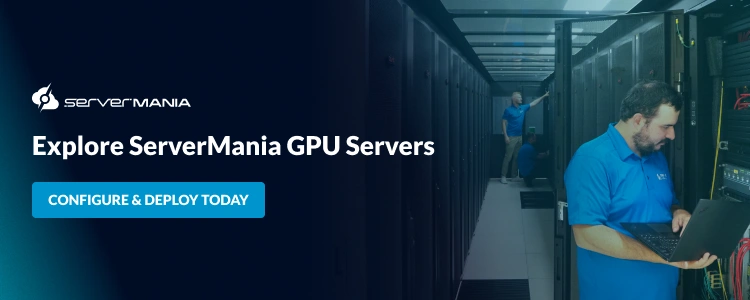
If you’re ready to accelerate your AI workloads and Natural Language Processing (NLP) tasks with ServerMania’s NVIDIA GPU Servers, request a quote today.
Our scalable processors, paired with optimized GPUs for machine learning, handle large datasets efficiently, ensuring your AI project runs smoothly across multiple systems.
With our enterprise-grade security and 24/7 support, your data stays protected while operations remain seamless. ServerMania delivers optimized infrastructure designed to meet the demands of modern AI workloads, so don’t wait and scale with confidence to unlock the full potential of your AI systems today.
Was this page helpful?

